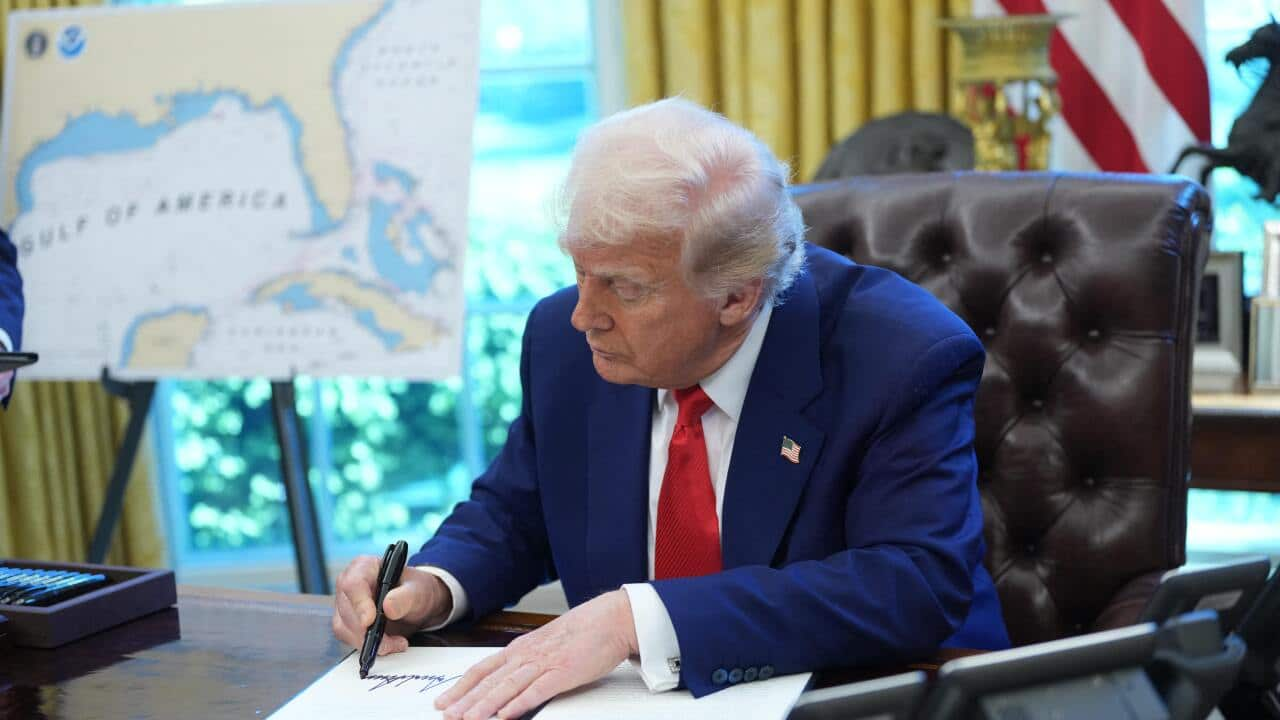The Trump administration has announced a 90-day pause on its plan to impose so-called 'reciprocal' tariffs on nearly all US imports.
But the pause does not extend to China, where import duties will rise to around 125 per cent, on top of an existing 20 per cent tariff that is already in place.
The move signals a partial retreat from what had been shaping up as a broad and aggressive trade war.
For most countries, the US will now apply a 10 per cent baseline tariff for the next three months.
But the White House made clear that its tariffs on Chinese imports will remain in place.
So why did President Trump back away from the broader tariff push?
The answer is simple: the economic cost to the US was too high.
Modelling the fallout
Using a global economic model, we have been estimating the macroeconomic consequences of the Trump administration's tariff plans as they have developed.
The following table shows two versions of the economic effects of the tariff plan:
1. 'pre-pause' – as the plan stood immediately before Wednesday's 90-day pause, under a scenario in which all countries retaliate except Australia, Japan, and South Korea (which said they would not retaliate)
2. 'post-pause' - after reciprocal tariffs were withdrawn.

Source: The Conversation
Heavy costs of the tariff war
Under the pre-pause scenario, the US would have seen real consumption fall by 2.4 per cent in 2025 alone. Real gross domestic product (GDP) would have declined by 2.6 per cent, while employment falls by 2.7 per cent and real investment (after inflation) plunges 6.6 per cent.
These are not trivial adjustments. They represent significant contractions that would be felt in everyday life, from job losses to price increases to reduced household purchasing power. Since the current US unemployment rate is 4.2 per cent, these results suggest that for every three currently unemployed Americans, two more would join their ranks.
Our modelling shows the damage would not just be short-term. Across the 2025–2040 projection period, US real consumption losses would have averaged 1.2 per cent, with persistent investment weakness and a long-term decline in real GDP.
It is likely that internal economic advice reflected this kind of outlook. The decision to pause most of the tariff increases may well be an acknowledgement that the policy was economically unsustainable and would result in a permanent reduction in US global economic power. Financial markets were also rattled.
The scaled-back plan: still aggressive on China
The new arrangement announced on 9 April scales the higher tariff regime back to a flat 10 per cent for about 70 countries, but keeps the full weight of tariffs on Chinese goods at around 145 per cent.
Rates on Canadian and Mexican imports remain at 25 per cent.
In response, China has announced an 84 per cent tariff on US goods.
The table's 'post-pause' column summarises the results of the scaled-back plan if the pause becomes permanent. For consistency, we assume all countries except Australia, Japan and Korea retaliate with tariffs equal to those imposed by the US.
As is clear from the 'post-pause' results, lower US tariffs, together with lower retaliatory tariffs, equal less damage for the US economy.
Tariffs applied uniformly are less distortionary, and significant retaliation from just one major partner (China) is easier to absorb than a broad global response.
However, the costs will still be high. The US is projected to experience a 1.9 per cent drop in real consumption in 2025, driven by lower employment and reduced efficiency in production. Real investment is projected to fall by 4.8 per cent, and employment by 2.1 per cent.
Perhaps we should not be surprised that the costs are still so high. In 2022, China, Canada and Mexico accounted for almost 45 per cent of all US goods imports, and many countries were already facing 10 per cent reciprocal tariffs in the 'pre-pause' scenario.
Trump's tariff pause has not changed duty rates for these countries.
What does this mean for Australia?
Much of the domestic commentary in Australia has focused on the risk of collateral damage from a US-China trade war. Given Australia's economic ties to both countries, it is a reasonable concern.
But our modelling suggests that Australia may actually benefit modestly. Under both scenarios, Australia's real consumption rises slightly, driven by stronger investment, improved terms of trade (a measure of our export prices relative to import prices), and redirection of trade flows.
One mechanism is what economists call trade diversion: if Chinese or European exporters find the US market less attractive, they may redirect goods to Australia and other open markets.
At the same time, reduced global demand for capital, especially in the US and China, means lower interest rates globally. That stimulates investment elsewhere, including in Australia. In our model, Australian real investment rises under both scenarios, leading to small but sustained gains in GDP and household consumption.
These results suggest that, at least under current policy settings, Australia is unlikely to suffer significant direct effects from the tariff increases.
However, rising investor uncertainty is a risk for both the global and Australian economies, and this is not factored into our modelling. In the space of a single week, the Trump administration has whipsawed global investor confidence through three major tariff announcements.
A temporary reprieve
Tariffs appear to be central to the administration’s economic program. So Trump’s decision to pause his broader tariff agenda may not signal a shift in philosophy: just a tactical retreat.
The updated strategy, high tariffs on China and lower ones elsewhere, might reflect an attempt to refocus on where the administration sees its main strategic concern, while avoiding unnecessary blowback from allies and neutral partners.
Whether this narrower approach proves durable remains to be seen. The sharpest economic pain has been deferred. Whether it returns depends on how the next 90 days play out.
James Giesecke is a professor at the Centre of Policy Studies and the Impact Project, Victoria University.
Robert Waschik is associate professor and deputy director at the Centre of Policy Studies, Victoria University.




